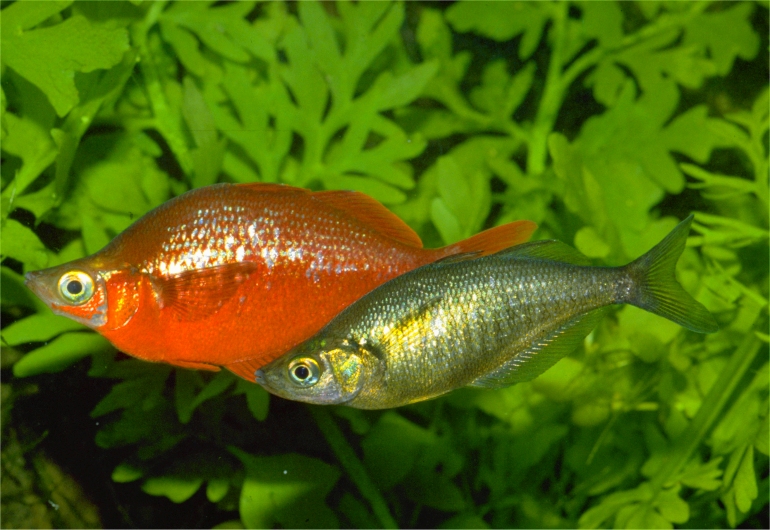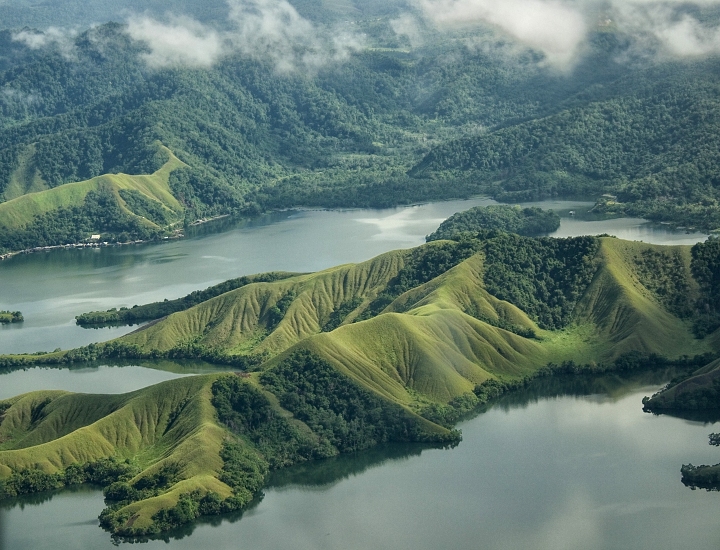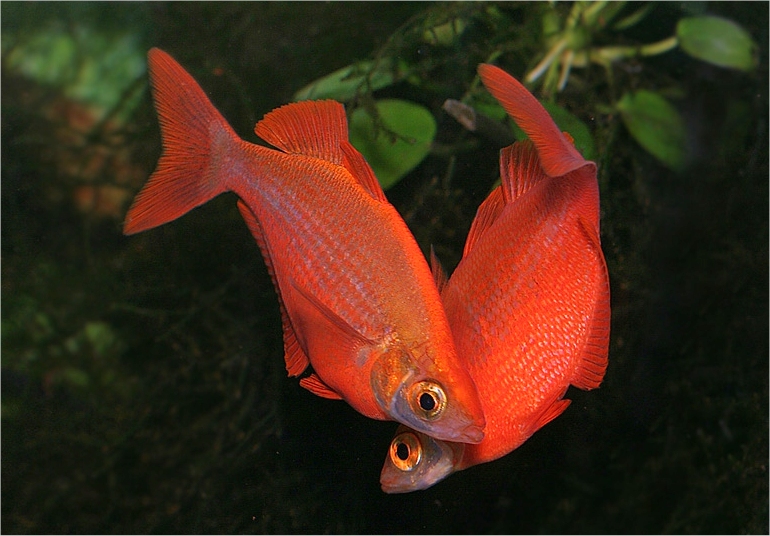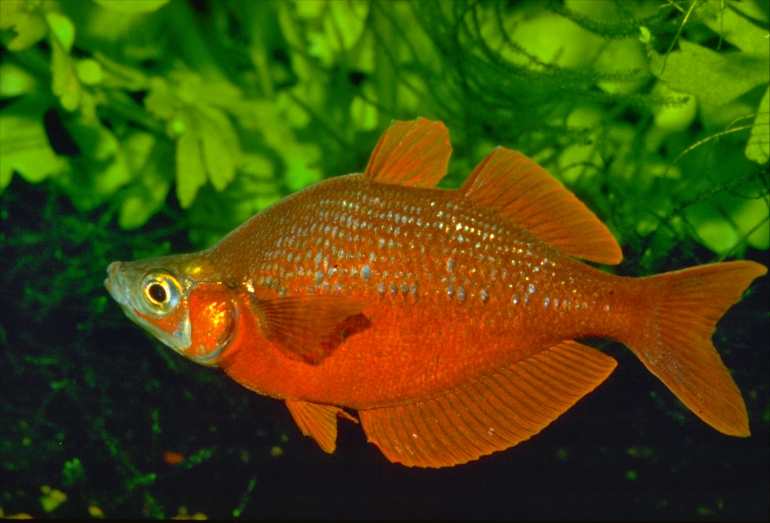|
 |
Glossolepis incisus - (male & female) - photo© Neil Armstrong |
Weber, 1908
Salmon-Red Rainbowfish
Species Summary
Female Glossolepis incisus have a yellowish olive body colour with a golden iridescence to the scales, and clear fins. The males on the other hand are brilliant, the entire body and fins are a bright salmon-red colour. Some of the scales have a silvery sheen, which creates a most unusual effect over the red background colour. Young fish are all rather dull in colour, being an overall olive greenish colour with a trace of silvery sheen. However, once the fish reach a length of 4 to 5 cm the males begin to colour up. Once the colour change begins to occur it progresses quite rapidly. By the time the fish are 7 to 8 cm long the males should have their full intense red colouration. Males are typically deeper bodied than females and have a high rounded back which gives them the appearance of having a relatively small head and disproportionately large eyes. Males may reach a maximum size of 15 cm, but females are usually less than 12 cm.
Glossolepis differ from other melanotaeniids by a combination of characters which includes distinctly crenulate scale margins, a high gill raker count, spine at the beginning of the second dorsal fin taller than first spine of first dorsal fin, relatively elongate pectoral fins, a unique premaxillary dentition and characteristic profile of the head, nape, and dorsal and anal fins.
 |
Lake Sentani - photo© Gary Lange |
Distribution & Habitat
Glossolepis incisus are found only in Lake Sentani. Lake Sentani is located some 10 kilometres west of Jayapura at the NE extremity of West Papua. It is an irregularly shaped lake with approximate dimensions of 28 km (E-W) by 19 km (N-S) and a surface area of 104 km². Its blue-green waters are dotted with at least 16 small islands, and it is surrounded by hillsides in the south and the Cyclops Mountains in the north, which separate the lake from the Pacific Ocean. Lake Sentani is by far the largest of the West Papuan lakes and has a catchment area of about 600 km². About 35 small rivers flow into the lake, and there is one natural outlet in the south-eastern tip, via the Jafuri and Tami rivers to the Pacific Ocean near the Papua New Guinea border. The lake is divided into three main sections with recorded depths of 7 to 52 metres. According to surveys in 1970-71, 1984 and 1987 the lake is thermally unstratified, with surface temperatures of 29-32°C and pH 6.2-6.8. Rainbowfishes are generally found around the margins of the lake. Large numbers are found congregating around submerged aquatic vegetation, fallen tree branches etc.
The overall abundance of Glossolepis incisus was considered high in Lake Sentani during surveys in November-December 2009, July-November 2010 and October 2011, with more than 30 individuals per site per visit, collected during a three-year survey (Ohee 2013). The highest abundance was found at water depths of 0-60 cm and in the early morning, 06.00-09.00 am, and afternoon, around 16.00-18.00 pm. Some fish were also detected at around a depth of two meters, as well as some at depths exceeding two meters. Local spearfishermen reported seeing Glossolepis incisus in even deeper water, while seine fishermen were observed catching them. However, the low number of individuals found in both cases suggests that although they can be found in such deep water, the occurrence is rare. Fish were collected along the shoreline of the lake and mouths of two creeks, namely Waena Creek and Jembatan II Creek. Fish with smaller body lengths (<90 mm SL) tended to occupy the very shallow area near the shoreline, while fish with larger bodies (>90 mm SL) were rare along the shoreline. The mean body lengths (SL) of the collected specimens were 65.52-70.72 mm.
 |
Glossolepis incisus (males) - photo© Hristo Hristov |
Male Glossolepis incisus were more abundant than females in the shallow waters along the shoreline, the latter being found more commonly in deeper waters. Moreover, they usually avoided high light intensities by moving to shaded areas or deeper water. Therefore, fish were rarely found in shallow waters during periods of high light intensity, such as from late-morning to mid-afternoon, having moved to deeper waters. In cases where they remained near the surface, they had moved to shadowed areas, such as under stilt houses or amongst submerged plants. The substrate of the lake consists of mud and sand, and water plants grow in shallow areas to cover 25% of the lake's area.
Glossolepis incisus are known to prefer habitats with submerged plants, roots, and wood debris, which are all commonly found along the shorelines. In Lake Sentani, various types of terrestrial vegetation were also found along the shoreline. The vegetation grows naturally, or is planted by people who reside in the area. Generally, the fish were abundant amongst the roots of some plants, such as the Sago Palm (Metroxylon sagu), or large trees, such as Ficus spp., as well as grasses. Large trees also provided shade for the fish. Hydrilla verticillata was the most ubiquitous water plant, being found in most locations. Hydrilla verticillata, Ceratophyllum demersum, Myriophyllum, Potamogeton and Vallisneria are some aquatic plants found in the deeper parts of the lake, while water lilies (Nymphaea, Nymphoides), Ipomoea aquatica, Bulrushes, and floating aquatic plants Eichhornia crassipes, Salvinia molesta and Lemna are found in the shallow parts. Eichhornia crassipes is the most common plant and is found throughout the entirety of Lake Sentani, often disturbing water-based transportation. Pandanus and Sago (Metroxylon sagu) grow on the shore.
The overall habitat preference of Glossolepis incisus was clear, shallow water, sand, gravel, and cobble substrate, and shoaling amidst Hydrilla verticillata, Valisneria, Eichhornia crassipes, Metroxylon sagu, and grasses. The availability of food also attracted fish to certain areas, such as under the traditional stilt houses, roots of some plants, litter, and wood debris. The pollen of terrestrial plants, as well as terrestrial insects, also served as a food source for the fish, along with the larvae of aquatic insects and algae. Roots of plants were also important for refuge. These factors influenced their distribution and habitat selection, and consequently, its abundance (Ohee 2013).
Unfortunately, because of its proximity to the provincial capital Jayapura and the large population around it, Sentani is no longer the pristine lake it once was. Despite the fact that Lake Sentani has been identified as an important ecosystem for species conservation (Conservation International 1999; Polhemus et al. 2004), the area remains under no protection. Meanwhile, human activities surrounding the lake have led to noticeable deforestation around it, water pollution, and the introduction of exotic species. Although Glossolepis incisus has been largely unaffected by the present concentrations of pollutants in Lake Sentani, the continuing human population growth around the lake will result in concentrations that will be hazardous to Glossolepis incisus and its co-inhabitants.
 |
Glossolepis incisus (male) - photo© Neil Armstrong |
Remarks
Glossolepis incisus was originally collected from Lake Sentani during the 1899-1900 Siboga Expedition to the Dutch East Indies (West Papua). The discovery and collection of rainbowfishes in remote places in New Guinea has always been very difficult and it wasn't until 1973 before live specimens of this species were collected. In 1973, A. Werner, Jr. of Munich, and E. Frech of Memmingen, Germany collected live specimens during a collecting trip to Java, Celebes, and West Papua. They took a number of colourful fishes back to Europe, including Glossolepis incisus. Werner and Frech are also credited with the introduction of another beautiful and appealing rainbowfish to the aquarium hobby - Iriatherina werneri.
Literature
Allen G.R. & N. J. Cross (1980) Descriptions of five new rainbowfishes (Melanotaeniidae) from New Guinea. Records of the Western Australian Museum 8 (3): 377-396.
Ferreira A.V., M.V. Vidal Jr., D.R. Andrade, G.S. Yasul, P.P. Mendonca, and D.C. Mattos (2009) Consumo de vitelo durante o desenvolvimento embrionário de Melanotenia-maçã, Glossolepis incisus, Weber, 1907 (Melanotaeniidae). Ciência Animal Brasileira (UFG. Impresso) 10: 721-729.
Ohee H.L. (2013) The Ecology of the Red Rainbowfish (Glossolepis incisus) and the Impact of Human Activities on Its Habitats in Lake Sentani, Papua. Dissertation, Georg-August Universität Göttingen.
Polhemus D.A., R.A. Englund and G. Allen (2004) Freshwater Biotas of New Guinea and nearby islands: analysis of endemism, richness, and threats. Report prepared for Conservation International, Washington, D.C. 62 pp.
Said D.S., W.D. Supyawati and Noortiningsih (2005) Effect of Feeding Type and Light Intensity to The Colour Appearance of Male Red Rainbow Fish, Glossolepis incisus. Jurnal Iktiologi Indonesia 5(2): 61-67.
Siby L.S., M.F. Rahardjo and D.S. Sjafei (2009) Reproductive biology of red rainbowfish (Glossolepis incisus Weber 1907) in Sentani Lake. Jurnal Iktiologi Indonesia, 9(1):49-61.
Weber M. (1907). Süsswasserfische von Neu-Guinea ein Beitrag zur Frage nach dem früheren Zusammenhang von Neu-Guinea und Australien. In: Nova Guinea. Résultats de l'expédition scientifique Néerlandaise à la Nouvelle-Guinée. Süsswasserfische Neu-Guinea 201-267.
Adrian R. Tappin
Updated June, 2016



|
|

